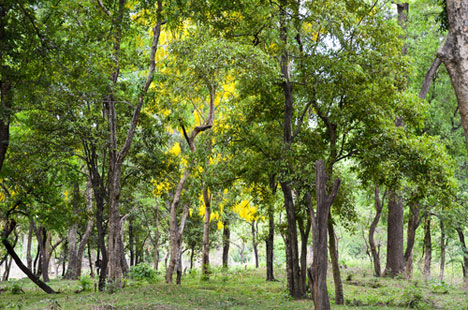
New Delhi: The Centre's Draft National Forest Policy (DNFP) 2018 appears focused on enhancing tree cover and wood production rather than preserving forest ecosystems and could take away the legal rights of forest-dwellers, conservation scientists and political activists have said.
The CPM and independent conservation experts have expressed concern that the DNFP 2018, released by the Union environment ministry last month for public responses, persists with equating plantations with forests and fails to address current threats to diverse forest ecosystems.
The 2018 draft sets a goal of maintaining a minimum of one-third of India's land area under forest or tree cover, underscores the need to protect natural forests, proposes strategies to increase forest productivity and recommends steps to increase area under plantations.
The Forest Survey of India had estimated in a report released earlier this year that forest and tree cover had increased since 2015 by 1 per cent, with forests expanding to 21 per cent and tree cover to 2.85 per cent of India's geographical area by 2017.
"Simply focusing on increasing productivity is not forest management - plantations are not forests," said Abi Tamim Vanak, a conservation scientist with the Ashoka Trust for Research in Ecology and Environment, Bangalore. "There are a range of other natural ecosystems that are as important as forests."
"What we need is a good ecosystem policy that covers forests as well as savannas, wetlands, deserts among other ecosystems," he said.
The CPM has demanded the withdrawal of the DNFP 2018, saying it is a blueprint to commercialise and privatise forests, promote plantations, eliminate the rights of tribals and traditional forest-dwellers in ownership and control of non-timber forest produce.
The policy threatens to change the character of natural forests to plantation forests and undermine ecological and social services such as water recharge, erosion checking, fuel and fodder that forests provide, the CPM said in a note submitted to the environment ministry by politburo member Brinda Karat.
The note highlights sections of the draft that recommend "private participation" and promotion of "commercially important species such as teak, sal, sisham", saying it seeks to "meet expectations of corporate interests to harness natural resources for their private profit and gain".
While the Forest Rights Act allows forest-dwellers a say in forest-related decisions, the note said, the draft policy "snatches away" the rights of gram sabhas (village panels) for management of forests and instead hands it over to proposed centrally controlled entities.
"The gram sabha, which has powers of forest management... is to be subordinated to a government and forest department controlled body acting to a plan decided in Delhi or in state capitals which have nothing to do with local communities' wishes, plans, or requirements," the CPM said.
Other conservation ecologists also said they were concerned at the absence of focus on non-forest ecosystems.
"Many endangered species are found in our grasslands," Asad Rahmani, a member of the governing board of the non-government Wetlands International South Asia, told The Telegraph. "The Great Indian bustard, the black buck, the grey wolf are all grassland species and endangered."
Wetland specialists appear concerned that the policy does not provide adequate emphasis on the need to conserve critical ecosystems such as coastal mangroves.
"Studies suggest that coastal mangroves can sequester 50 times the carbon that terrestrial forests absorb," said Ritesh Kumar, conservation programme manager with Wetlands.
The 2018 draft highlights the importance of protecting "sensitive ecosystems" including coastal and marine areas, mangroves and temperate and sub-alpine forests, and alpine meadows but, conservation scientists say, it lacks technical details on how to achieve these objectives.










